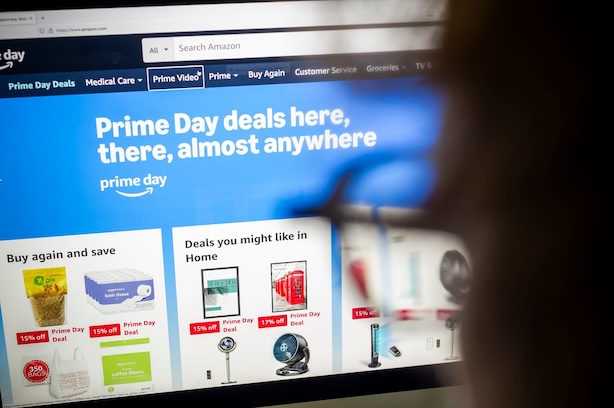How to Shop Safely During Amazon Prime Day
As Amazon Prime Day approaches (July 8-11, 2025), millions of shoppers are gearing up for what promises to be one of the biggest online shopping events of the year. But while you’re hunting...
Jul 03, 2025 | 8 MIN READ
- Trending Articles
-
16 Billion Stolen Logins for Apple, Google, Facebook and More: How to Stay Safe
Jun 23, 2025 | 7 MIN READ
-
Love, Lies, and Long Flights: How to Avoid Romance Scams While Traveling This Summer
Jun 16, 2025 | 7 MIN READ
-
Introducing Scam Stories: A McAfee Campaign to End Scam Stigma
May 14, 2025 | 4 MIN READ
How to Shop Safely During Amazon Prime Day
As Amazon Prime Day approaches (July 8-11, 2025), millions of shoppers are gearing up for what promises...Jul 03, 2025 | 8 MIN READ
How to Know If Your Phone Has Been Hacked
It’s often pretty easy to tell when a piece of your tech isn’t working quite right. The...Jul 02, 2025 | 15 MIN READ
How Criminals Are Using AI to Clone Travel Agents and Steal Your Money
Your dream vacation could become a nightmare if you fall for these sophisticated AI-powered scams. The travel...Jun 25, 2025 | 6 MIN READ
How to Know If Your Phone Has Been Hacked
It’s often pretty easy to tell when a piece of your tech isn’t working quite right. The...Jul 02, 2025 | 15 MIN READ
7 Signs Your Phone Has a Virus and What You Can Do
We use our smartphones for everything under the sun, from work-related communication to online shopping, banking transactions,...May 24, 2025 | 11 MIN READ
New Android Malware Sneaks Past Security by Pretending to Be Real Apps
Cybercriminals are getting smarter. They’re now using a development toolkit called .NET MAUI to create fake apps...Mar 24, 2025 | 4 MIN READ
How To Do A Virus Scan
Learn everything you need to know about virus scans on any device and how to steer clear...May 19, 2025 | 9 MIN READ
Introducing Scam Stories: A McAfee Campaign to End Scam Stigma
When Grey’s Anatomy actor Chris Carmack and musician Erin Slaver tried to order custom patio cushions from...May 14, 2025 | 4 MIN READ
Cory’s Scam Story: A Fake Text Nearly Took His Identity
Cory considers himself pretty cautious. But like millions of people juggling packed schedules, one click on a...May 13, 2025 | 4 MIN READ
This Week in Scams: $16.6 Billion Lost, Deepfakes Rise, and Google Email Scams Emerge
Welcome to the first edition of This Week in Scams, a new weekly series from McAfee breaking...Apr 25, 2025 | 4 MIN READ
Your Phone Is the #1 Target in a New Wave of IRS Scams, McAfee Finds
As Tax Day looms and last-minute taxpayers feel the pressure, a surge of IRS scams is on...Apr 01, 2025 | 7 MIN READ
AV-Comparatives Crowns McAfee as 2024’s Leader in Online Protection and Speed
McAfee Total Protection users can feel even more secure online knowing that AV-Comparatives has named it the...Jan 16, 2025 | 2 MIN READ
How To Protect Your Family’s Smartphones While on Vacation
With families hitting the road for vacations once again, smartphones and chargers are coming along for the...Jun 10, 2025 | 9 MIN READ
Protect Your Family From Scams With These 5 Key Online Safety Tips
Scams are big business for cybercriminals, and they’re getting more sophisticated than ever. According to McAfee’s State...Mar 04, 2025 | 4 MIN READ
How to Be Your Family’s Digital IT Hero for the Holidays
The holiday season often brings a rush of new gadgets—smartphones, tablets, laptops, and smart home devices—into households....Nov 18, 2024 | 6 MIN READ
When AI Voices Target World Leaders: The Growing Threat of AI Voice Scams
If someone called you claiming to be a government official, would you know if their voice was...Jul 09, 2025 | 7 MIN READ
How to Protect Yourself from Concert and Festival Ticket Scams
Summer festival season is upon us, and music lovers are eagerly anticipating everything from The Weeknd tickets...Jul 08, 2025 | 7 MIN READ
How to Shop Safely During Amazon Prime Day
As Amazon Prime Day approaches (July 8-11, 2025), millions of shoppers are gearing up for what promises...Jul 03, 2025 | 8 MIN READ
- Trending Articles
-
16 Billion Stolen Logins for Apple, Google, Facebook and More: How to Stay Safe
Jun 23, 2025 | 7 MIN READ
-
Love, Lies, and Long Flights: How to Avoid Romance Scams While Traveling This Summer
Jun 16, 2025 | 7 MIN READ
-
Introducing Scam Stories: A McAfee Campaign to End Scam Stigma
May 14, 2025 | 4 MIN READ

Introducing McAfee+ Ultimate
Our most comprehensive privacy, identity, and device protection. Click on the link to select a perfect plan to fit your online life
Get protection now















